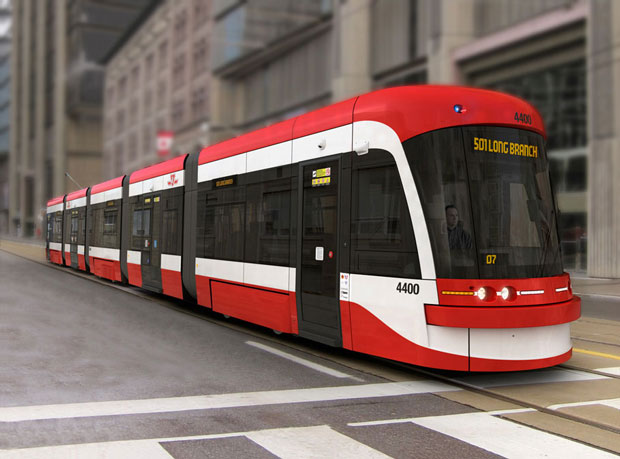New Competition Generates Challenges for Thunder Bay
Thunder Bay – Business – Thunder Bay has, in the past held a virtual monopoly on contracts with the Toronto Transit Commission.
Since the 1950s, streetcars and then light rail passenger cars have been manufactured in the city.
The competitive nature of that business relationship has slowly changed.
In order to meet the demands of a growing metropolitan city and modernize its transit system, the Toronto Transit Commission (TTC) has changed its purchasing strategy.
The TTC approved a plan to invest $550-million in new vehicles and upgrades to the transit system on Thursday, October 22. This includes buying 600 new buses, 70 new streetcars, and 13 more subway trains. If senior governments provide further funding, the TTC plans to buy 80 new subway trains for Lines 1 and 2.
Electrifying buses is also part of this plan as the City is committed to its goal and leading by example, and vehicles generate about one-third of the emissions in Toronto today.
In Thunder Bay it is no longer Bombardier operating the manufacturing facility but Alstom.
Competition will present new challenges.
The Bombardier plant in Thunder Bay faced several challenges, including a lack of consistent work, limited resources, and a need to keep up with the rapidly changing technology in the rail car industry.
In addition, the plant had to contend with a history of delivery delays and poor quality control, resulting in a backlog of orders, especially for the TTC’s Flexity streetcars.
The recent acquisition of the plant by Alstom, workers have become more positive, as Alstom has committed to taking on future contracts.
Hitachi Rail just published a major new report investigating attitudes towards public transport and smart mobility in eight cities around the globe, including Toronto, Canada. The first-of-its-kind study finds that three-quarters (75%) of people would choose a better-connected public transport system, rather than driving. The report finds a strong global demand for smart transport solutions to deliver enhanced cost, convenience and comfort, with a willingness to pay for improvements through increased taxes on private transport.
The research for the report was conducted by leading independent consumer research company, Savanta ComRes. The research investigated over 8,000 peoples’ attitudes in eight major global cities: Washington, D.C., Toronto, London, Paris, Dusseldorf, Turin, Dubai and Bangkok. Hitachi Rail commissioned the research to better understand the push and pull factors for using public transport and how they interact with Hitachi Rail’s smart, digital solutions the business is rolling out to support cities around the world.
Toronto’s views on public transport
Respondents in Toronto currently favor driving a personal vehicle to public transport (63%), driven strongly by crowd avoidance (72%), cost (63%) and convenience (44%). More than three-fourths (76%) of Torontonians see the positive environmental impact that public transport can bring, highlighting the need for a continued investment in new sustainability technology and initiatives throughout the sector.
Toronto respondents also cite the COVID-19 pandemic as having a strong impact on public transportation decisions, with more than two-thirds (67%) of Torontonians believing that the pandemic has changed how they travel now. While 54% are more likely to drive rather than use public transport because of the pandemic, 49% strongly or slightly agree that their choices in how they travel will change as we return towards a more normal environment post-pandemic
“Now that we are moving into a post-pandemic environment, we are encouraged to see how Toronto responds to public transport and the new technology, safety programs and sustainability practices that have become available since they last rode,” said Joe Pozza, President of Hitachi Rail, North America.
Additionally, Toronto ranks as one of the top cities surveyed interested in technology that can better alert riders of service disruptions (13%), show a full route planned and mapped out (12%) and provide real-time advice about how to get to their destination by the most efficient route (12%).
“Hitachi Rail recognizes the need for a more-connected public transit system in cities across the globe, including new apps and technology that eases many of the barriers holding potential riders back. We are bringing new digital services and systems into these areas to encourage riders to use public transport and lessen the impact of driving on the environment,” added Barr.
Global views on public transport (full research results)
What motivates peoples’ travel decisions?
The research provides useful insights for transport planners seeking to understand how to increase public transport usage. Overcrowding (48%) and busyness (42%) of services are the single biggest factors that put people off. In contrast, people identify the three C’s – cost, convenience and comfort – as their biggest motivators to travel, with 79% noting the appeal of the ability to avoid crowded services, and 78% highlighting the importance of shortest journey time, and cheapest travel option.
What do passengers want?
A powerful three-quarters (75%) of global respondents would likely choose a better-connected public transport system, rather than driving. People across cities also share a clear sense of how public transport networks can overcome existing barriers, placing an emphasis on the benefits of digitization. For example, 73% suggested they would be more likely to travel on public transport if they could see live information on crowding levels on services. This rises to almost 9 in 10 people in Bangkok. The research also shows the public have a strong general understanding of what ‘smart’ transport means, driven by high levels of take-up of digital apps, with 59% of respondents using them to plan or book their journeys.
However, the move towards digitization currently presents barriers as well. Almost two-thirds (63%) of respondents are put off from using public transport where they needed to use multiple different apps; while only just over half were willing to share their payment details with multiple travel apps. This reticence varies dramatically from country to country, with far lower trust in North America and the UK, compared to mainland Europe and Asia.
Across every city, the majority (averaging 71%) noted that they now travel differently following the pandemic. Those surveyed do however expect that how they travel will change again (59%). This provides hope for municipalities around the world, whose net-zero and air pollution targets require solutions that reduce the use of polluting vehicles.
How do we fund better-connected transport networks?
The research finds that people would also be prepared to pay more for better-connected public transport. When faced with the same option of a better-connected transport system but at a higher cost than driving, 3 in 5 people (60%) still suggested that they would choose to travel this way.
The study also finds that one possible route for charging and paying for better-connected public transport could be via new or increased road charges. Overall, 63% were in favor of this as a revenue source, with only 14% against – despite almost two-thirds of people (63%) believing that they now drive more post-pandemic. Even in cities with the highest percentage of driving commuters, there is still a majority in favor of such taxes (51% in Toronto and 52% in Washington, D.C.).
Commenting on the launch of the report, Ludmil Neykov, Chief Digital Officer, Hitachi Rail, said:
“Cities face significant pressure to reduce the cost of operating their transport networks, cut congestion and minimize CO2. This can be achieved by moving people out of their cars and onto public transport, which poses a significant challenge for many cities and for many reasons.
“Our research shows that three-quarters of people would use public transport more often if it was better-connected and more convenient, and that access to a single smart phone app for the entire network would be preferable. From Washington, D.C., to Paris, and from Toronto to Bangkok, we are ready help cities to reduce costs, carbon and congestion through our digital systems and services.”
Hitachi Smart Mobility vision
As a global leader in transport and technology, Hitachi Rail’s vision for smart mobility is to digitize and optimize every part of the journey across different types of public transport.
In July 2022, Hitachi Rail launched its first smart mobility project in Genoa, Italy, digitally connecting public and private hire transport across the entire city. Using technology from Hitachi’s new smart mobility suite called Lumada Intelligent Mobility Management, trial-users had access to the 360Pass smart phone app which enabled them to plan their multi-modal journey with live-time service updates, including information on the crowding levels of incoming bus services. By placing over 7,000 Bluetooth sensors on services and at stops around the city, passengers could also travel using hands-free ticketing, with the app simply calculating the best-priced multi-modal fair at the end of the day. More recently, Hitachi Rail also launched its first commercial application of this technology in Trentino.
The new suite embodies Hitachi Rail’s holistic vision for smarter mobility, incorporating solutions across three key areas: smart ticketing, mobility management and electrified mobility solutions. While the firm is known for delivering trains and rail infrastructure around the world, including the iconic Shinkansen bullet trains, the digitization of transport systems is an important and growing area of focus.
So? What About Aston?
Alstom is best known for its integrated systems and solutions for the transportation sector. The company offers a wide range of solutions, from trains to metros, tramways, and e-buses; passenger solutions; customized services like maintenance and repair; and digital mobility solutions.
Alstom is also well-recognized for its commitment to sustainability, offering innovative solutions that promote greener and smarter mobility.
Additionally, Alstom is a global leader in the digital age, utilizing cutting-edge technology to provide customers with the most efficient solutions.
About Hitachi Rail:
Hitachi Rail is a fully integrated, global provider of rail solutions across rolling stock, signaling, service & maintenance, digital technology and turnkey solutions. With a presence in 38 countries across six continents and around 14,000 employees, our mission is to contribute to society through the continuous development of superior rail transport solutions. We are proud of our global achievements, from our world famous ‘bullet trains’, to our signaling solutions and turnkey projects, state-of-the-art traffic management and digital solutions. Drawing on the wider Hitachi Group’s market-leading technology and research-and-development capabilities, we strive for industry leading innovations and solutions that can deliver value for customers and sustainable railway systems that benefit wider society. For information about Hitachi Rail, visit www.hitachirail.com.
What will the Future Bring?
Ontario is taking steps to ensure that rail manufacturing remains an important part of the province’s economy. The Ontario government has announced plans to invest in rail infrastructure and create a new state enterprise to oversee the operations of High Frequency Rail (HFR).
This will include the construction of a new state-of-the-art manufacturing facility that will produce the next generation of rail cars and locomotives. The facility will be located in southwestern Ontario and is projected to create up to 500 jobs. Investment in rail infrastructure and the new manufacturing facility will support local businesses and create a more efficient, environmentally friendly, and cost-effective way to transport goods and people.
The Future of Rail examines how the role of rail in global transport might be elevated as a means to reduce the energy use and environmental impacts associated with transport.







